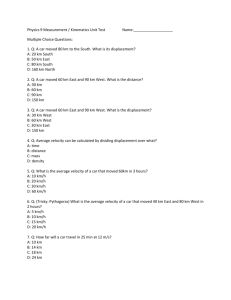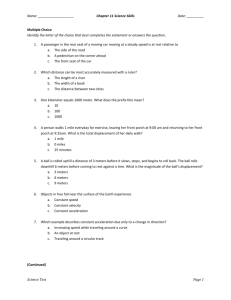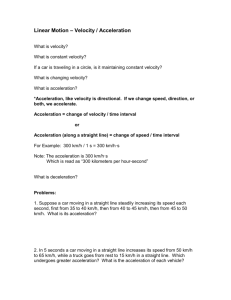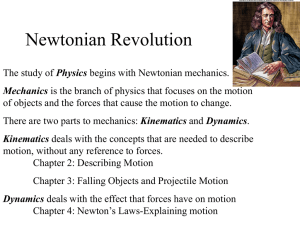Name: BRING YOUR CALCULATOR ON TEST DAY Unit 2 Study
advertisement
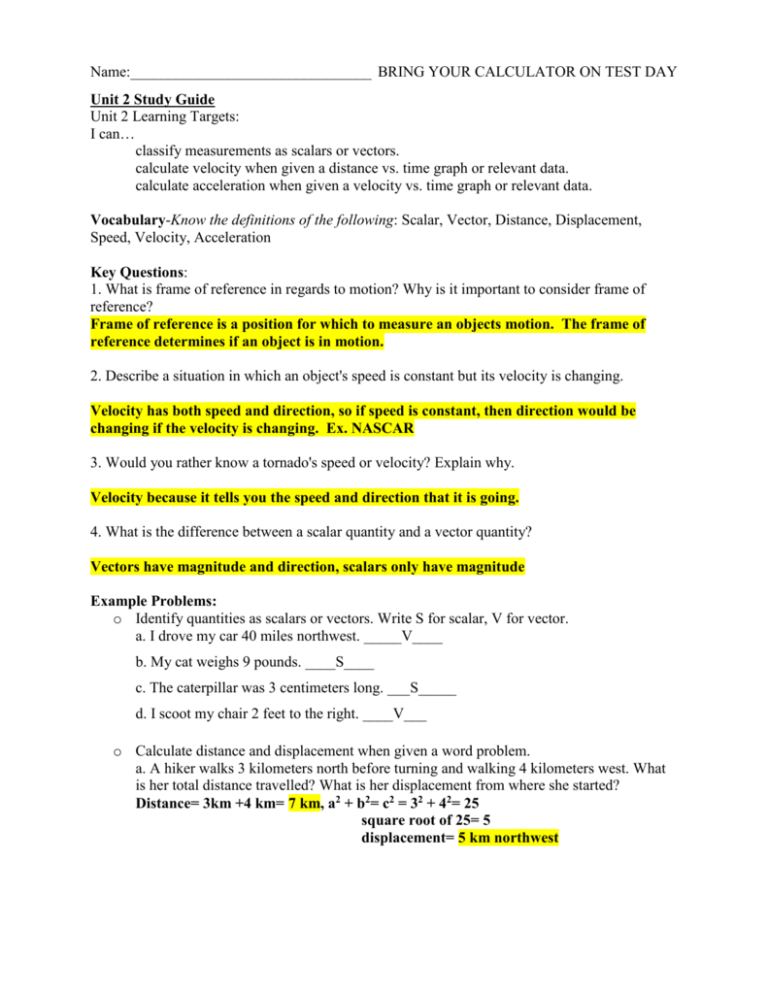
Name:________________________________ BRING YOUR CALCULATOR ON TEST DAY Unit 2 Study Guide Unit 2 Learning Targets: I can… classify measurements as scalars or vectors. calculate velocity when given a distance vs. time graph or relevant data. calculate acceleration when given a velocity vs. time graph or relevant data. Vocabulary-Know the definitions of the following: Scalar, Vector, Distance, Displacement, Speed, Velocity, Acceleration Key Questions: 1. What is frame of reference in regards to motion? Why is it important to consider frame of reference? Frame of reference is a position for which to measure an objects motion. The frame of reference determines if an object is in motion. 2. Describe a situation in which an object's speed is constant but its velocity is changing. Velocity has both speed and direction, so if speed is constant, then direction would be changing if the velocity is changing. Ex. NASCAR 3. Would you rather know a tornado's speed or velocity? Explain why. Velocity because it tells you the speed and direction that it is going. 4. What is the difference between a scalar quantity and a vector quantity? Vectors have magnitude and direction, scalars only have magnitude Example Problems: o Identify quantities as scalars or vectors. Write S for scalar, V for vector. a. I drove my car 40 miles northwest. _____V____ b. My cat weighs 9 pounds. ____S____ c. The caterpillar was 3 centimeters long. ___S_____ d. I scoot my chair 2 feet to the right. ____V___ o Calculate distance and displacement when given a word problem. a. A hiker walks 3 kilometers north before turning and walking 4 kilometers west. What is her total distance travelled? What is her displacement from where she started? Distance= 3km +4 km= 7 km, a2 + b2= c2 = 32 + 42= 25 square root of 25= 5 displacement= 5 km northwest Name:________________________________ BRING YOUR CALCULATOR ON TEST DAY b. A car drives 50 kilometers north before making a U-turn. It then travels 45 kilometers south. What is the car's total distance travelled? What is the car's displacement from where it started? Distance= 50 km + 45 km = 95 km Displacement = 50 km – 45 km = 5 km north o Calculate speed, distance, or time using the triangle. a. A horse runs a distance of 2,000 meters in 400 seconds. What is the horse's average speed over this period of time? Speed = Distance/Time = 2,000 m/ 400 s = 5 m/s b. A car is travelling at a speed of 60 kilometers per hour. How long will it take the car to travel 300 kilometers at this speed? Time= Distance/Speed = 300 km/ 60 km/hr = 5 hr c. An ant is crawling at a speed of 3 centimeters per second. How far will it crawl in 5 seconds? Distance= Speed x time = 3 cm/s x 5 s = 15 cm o Calculate acceleration. YOU WILL BE GIVEN THE EQUATION. a. A ball is rolling down a hill. At the top of the hill, it has a speed of 2 m/s. By the time it reaches the bottom of the hill 3 seconds later, it has a speed of 10 m/s. What was its acceleration? Acceleration = (Vfinal - Vinitial) = (10 m/s – 2 m/s) = 2.67 m/s2 Time 3s b. A car is going 45km/h when it sees a school bus stopped ahead. It slows down to come to a stop 5 seconds later. What was its deceleration? Acceleration = (Vfinal - Vinitial) = (0 km/hr – 45 km/hr) = - 9 km/hr/s Time 5s o Use Distance Vs. Time graphs to calculate speed and interpret movement. What does the slope of a line on a D vs. T graph tell us? Speed Slope= Rise = Distance Run Time a. What is the graph telling us about the motion of the object from time 4 seconds to 6 seconds? The object is not moving. Name:________________________________ BRING YOUR CALCULATOR ON TEST DAY b. Calculate the object's average speed from 0 to 4 seconds. Speed = Distance = 30 m = 7.5 m/s Time 4s c. During what time period is the object moving fastest? How do you know? Between 2 and 4 seconds the object is moving the fastest because it has the steepest slope. o Use Velocity Vs. Time graphs to calculate acceleration, interpret movement, and find velocity. What does the slope of a line on a V vs. T graph tell us? Acceleration Slope= Rise = Velocity Run time a. In which parts of the graph is the object accelerating? Where is it decelerating? Positive acceleration from a-b, c-d, and g-h Negative acceleration from e-f b. Calculate the acceleration of the object from point A to point B. Acceleration = (Vfinal - Vinitial) = (20 m/s – 0 m/s) = 10 m/s/s or 10 m/s2 Time 2s




